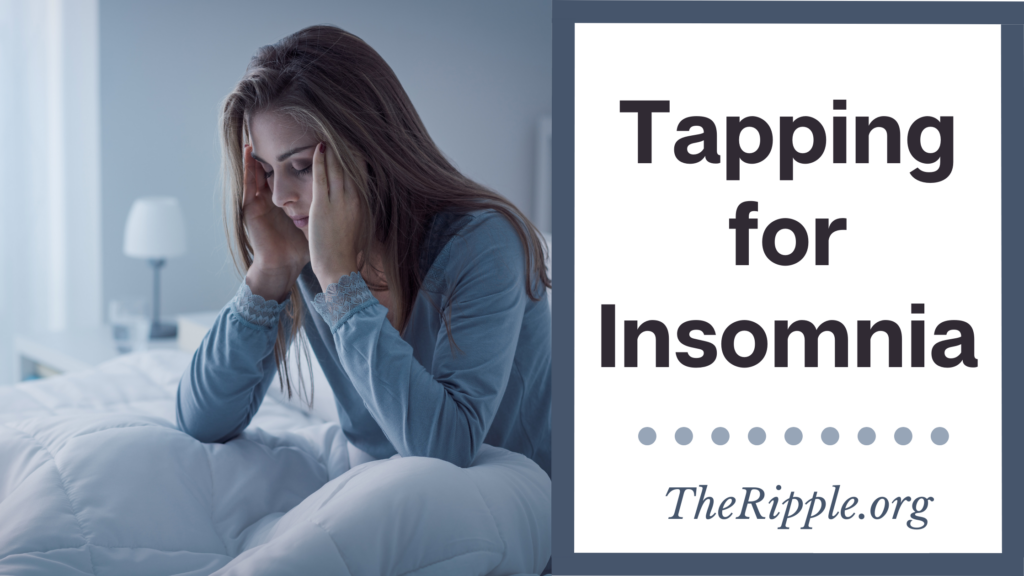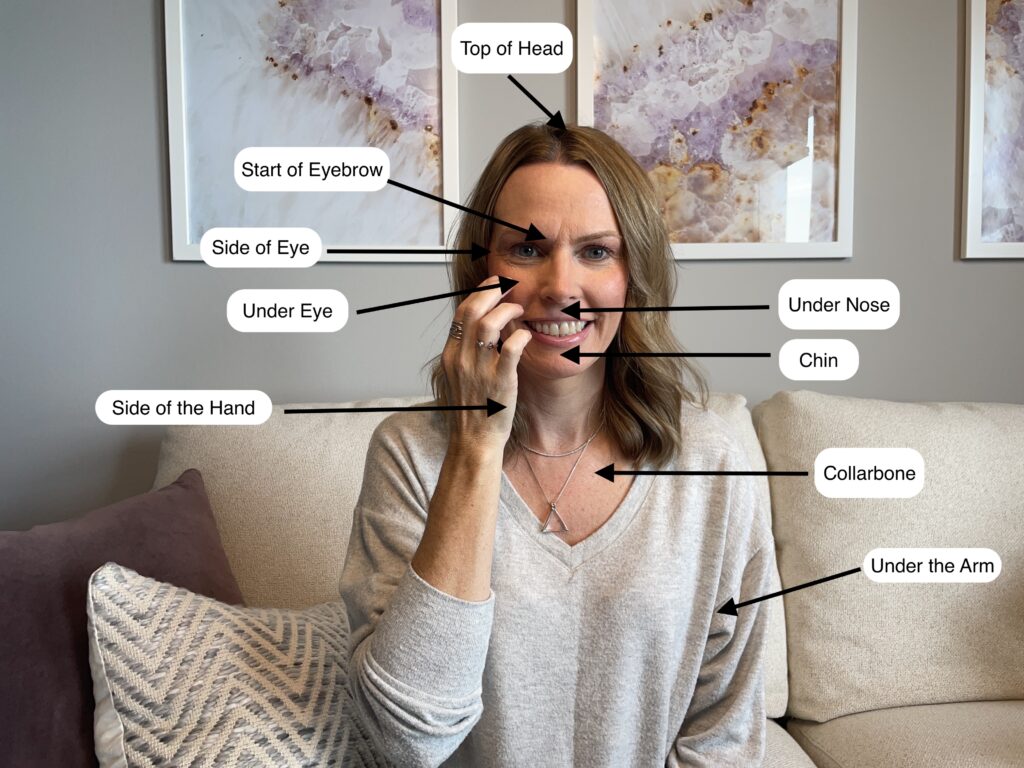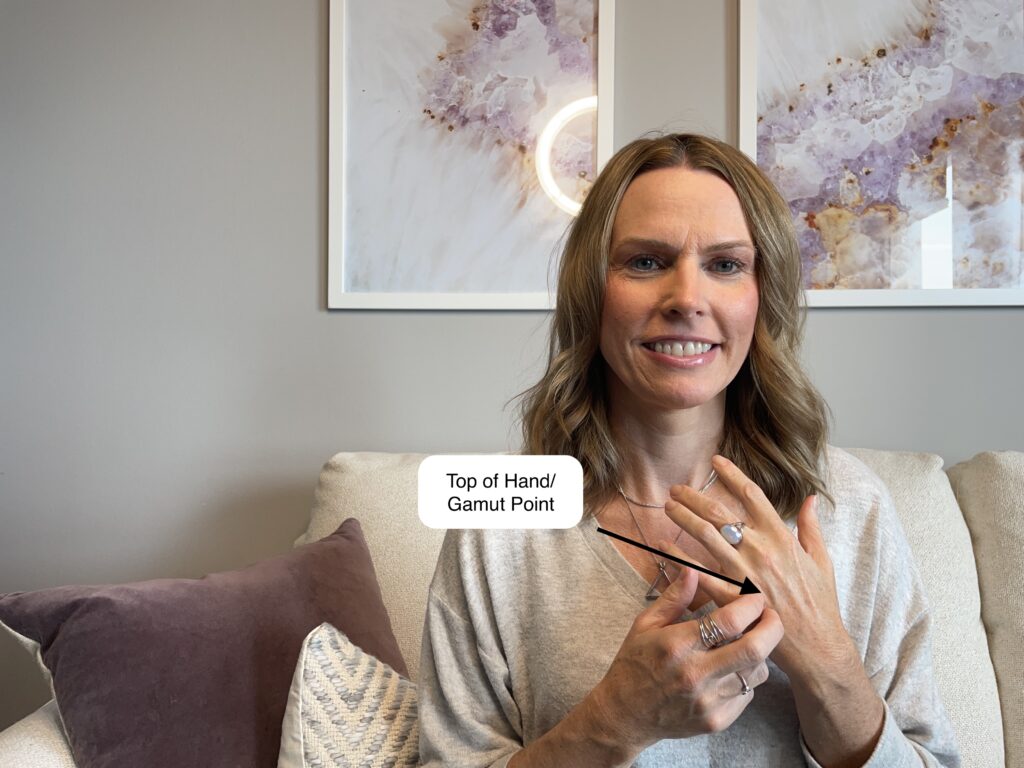
Are you battling insomnia? Struggling with too many sleepless nights?
Tossing and turning all night is no fun at all. What if there was a simple way you could help calm your mind and body without even getting out of bed? The good news is there is, and it’s completely free! So why not give it a try?!
This post will cover what EFT tapping is, how to use tapping for sleep, and how it may help you with insomnia.
What is EFT Tapping?
The Emotional Freedom Technique, also known as EFT tapping or just tapping, is a practical and easy tool that has been proven to help many people get a good night’s sleep. Whether you’re new to tapping or have been using tapping for years, it’s quick and easy enough to learn that by the time you finish this article, you’ll feel equipped to try tapping tonight for better sleep.
EFT is based on the principles of acupuncture in Chinese medicine, which uses needles to unblock energy to restore the body to health.
EFT commonly referred to as “tapping,” is a simple and practical stress management technique to help calm your mind and body. With EFT, you use your fingers to stimulate specific acupressure points or meridian points on your body by tapping on them with your fingertips while tuning in to a particular problem. The stimulation to the meridian points helps reduce negative emotions and stress, disrupting your sleep to restore energy balance in your body.
While this post is aimed at tapping specifically into the topic of insomnia, you may find it beneficial to support you in regulating your nervous system by tapping on negative emotions throughout the day. In fact, one of the “side effects” of tapping in itself is that it induces a calming effect, which can only help support preparing you for more restful sleep.
Effectiveness of EFT for Sleep
EFT seems to affect the amygdala, the stress center of the brain, and the hippocampus, the memory center. EFT has also been shown to lower cortisol levels, more commonly known as the “stress hormone.”
Tapping can help calm an overactive mind full of anxious thoughts and decrease cortisol, both of which can have a positive result in helping you have a better quality of sleep.
The first time you try tapping, it may feel like an unusual technique, but I encourage you to give it a few tries as it is a simple technique that has had ___ studies and research to support its effectiveness.
What are the Tapping Points?
There are ten primary tapping points we will use during this tapping session. You can use one hand or two, left or right hand; whatever is most comfortable and accessible for you. I have listed the points below in the order I use them with clients.
- Side of the hand or karate chop point
- Top of the head
- Beginning of the eyebrow
- Side of the eye
- Under the eye
- Under the nose
- Under the bottom lip
- Collar bone
- Under the arm, about 4 inches below the armpit
- Top of the hand or gamut point, the soft spot where the pinky and ring finger would meet on the top of the hand


Tapping for Insomnia
When tapping in order to prepare yourself for sleep, follow the basic six-step tapping protocol below.
- Identify the problem, such as “I’m struggling to sleep”
- Rate your intensity on a scale of 0-10, with 0 being the least intense and 10 being the most intense.
- Create your setup statement, such as “Even though I’m struggling to sleep, I deeply and completely love and accept myself.”
- Start by tapping on the side of the hand (the first point) repeating the setup statement three times. “Even though I’m struggling to sleep, I deeply and completely love and accept myself.”
- Tap on the remaining nine tapping points repeating the reminder phrase, “I’m struggling to sleep.”
- Take a deep breath, tune inward, and rate your intensity again from 0-10. Continue repeating this protocol until you feel your intensity is at a 0-2 and you are ready for restful sleep.
If you are already restless in bed, you may find the following abbreviated self-care protocol to be helpful.
Typically when we tap, we tap directly on each tapping point. However, since you may already be in bed, trying to induce sleep, you may want to try instead to visualize or think about tapping on each point without actually moving your body. This allows your body to lie in whatever way feels most comfortable as you drift off to sleep. You may also try actually tapping on each point; the choice is yours as to what feels most comfortable for you.
To begin doing visual tapping, just imagine your fingers tapping on the designated spot, starting with the top of your head while repeating your chosen sleep phrase, such as “I can’t sleep,” or I need sleep.” You may also find it helpful to add in the emotion you are feeling, such as “I can’t sleep frustration” or “I can’t sleep fear.”
Throughout each round of tapping, I like to take a good, deep inhale and exhale. This seems to help my body sync into the relaxation of the tapping more and prepare to drift off. Continue following all the tapping points while repeating the chosen eft statement such as “I can’t sleep” taking a deep inhale and exhaling between each point until you drift off to sleep or complete a round of tapping. Tapping on each point should be at a relaxed pace, and you may need to do more than one round of tapping before you drift off.
I recently worked with a client during an evening session. During her session, the main phrase we used was “I need sleep.” We tapped three rounds. The next day she reported, “that was amazingly helpful!” and that she “had a better night than I’ve had for weeks! Feeling energetic today!”
What Else is Tapping Good For?
In short, tapping is good for everything. Really, it is! Tapping is best utilized throughout the day so that stress does not accumulate during the day and leaves you up in the middle of the night. Tapping helps regulate your nervous system while calming your mind and body. When used therapeutically with acertified Evidence Based EFT practitioner like myself, tapping can heal the core issue, root cause, or past trauma that is interrupting your life. Tapping is clinically proven to help with curbing cravings, chronic pain, weight loss, physical pain, daily stress, grief, and so much more!
Sleep Hygiene Tips: Support a Good Night’s Rest
To help set yourself up for a good night’s sleep, you’ll want to support yourself with good sleep hygiene as well. Sleep hygiene is actions and habits that can help improve your sleep.
- Create a schedule & bedtime routine- tell your body it is time for going to bed. I personally like to shower an hour or so before bed after I’m done with work, including housework. It’s a way of telling my body we’re done and washing the day away. Even on days, I may have showered later in the day for whatever reason, I still shower again because when I have skipped it in the past, I’ve found my body to be more restless. You may choose to use some essential oils, wash your face, dim the lights, read a book, and make the routine yours. The goal is more about muscle memory and signals that are telling your mind it’s time to rest.
- Be mindful of what you eat and drink- If you are having sleep issues you want to be particularly mindful of anything stimulating afternoon, including sugar, caffeine, and alcohol.
- Create a relaxing bedroom environment- I have a no phone/computer zone in my bedroom. Between the bings and bongs and the blue light emitted from devices, none of it is conducive to restful sleep. In fact, if you do one thing to support a better night’s sleep, it is to keep your phone out of the bedroom. Invest in an alarm clock, you don’t need to use your phone as an alarm clock. If you have reasons you do need to hear your phone ring at night, place it away from the bed. I’ve also found being on devices close to bedtime is disruptive to my sleep and that my body is more anxious.
- Try blue light-blocking glasses- Studies show that wearing blue light-filtering glasses can help people sleep better. The gist of it is that the biochemical melatonin, which helps us to go to sleep rises in the evening. However, exposure to light with blue light having the strongest effect suppresses the production of melatonin, making it more difficult to fall asleep. So, wearing glasses in the evening that filter out blue light can support the body in it’s natural melatonin production to enable the process of falling asleep. Blue light filtering glasses also help reduce eye strain. If you already wear regular eyeglasses, you can find blue light-filtering glasses that go over your regular eyeglasses. I personally wear blue light-filtering eyeglasses myself.
- Get physical during the day- Exercise has been shown to help people sleep better by tiring their bodies out, increasing their need for sleep. Exercise also supports the reduction of stress by releasing endorphins. Aerobic activities in particular can support people with insomnia to get better sleep.
- Limit naps- Napping throughout the day disrupts the natural sleep cycle you are aiming for. If you must get a nap earlier in the day the better and limit naps to less than 30 minutes.
- Support your mental health- Stress and overthinking are common causes of sleep insomnia. The more you can do to support your overall well-being and mental health, the more likely you are to get better quality sleep.
EFT tapping is a great way to heal emotional distress and calm your mind and body while also helping you to get better sleep. Working with an EFT practitioner helps accelerate your progress and healing by providing individualized, targeted therapy.
Eft/Tapping is not meant to be a substitute for seeing a doctor or as a substitute for any medical advice.
Karla Kueber is here to support you in overcoming imposter syndrome and perfectionism so you can stop procrastinating, feeling stuck, and holding yourself back from your goals. Karla is here to help you believe in yourself and own your successes. You can book a freee discovery call with her here.